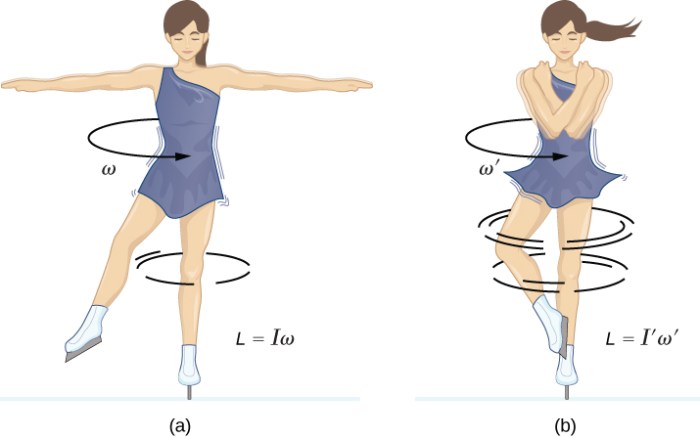An ice skater is spinning about a vertical axis, a graceful and challenging maneuver that showcases the athlete’s athleticism and artistry. This captivating movement involves a complex interplay of biomechanics, physics, and artistic expression.
Understanding the biomechanics of an ice skater’s spin reveals the forces acting on the skater, the intricate body positions and movements, and the crucial role of core muscles in maintaining balance and control.
Biomechanics of an Ice Skater Spinning
An ice skater spinning about a vertical axis undergoes a complex interplay of forces. Centripetal force, provided by the skater’s inside edge, keeps them moving in a circular path. Simultaneously, gravity pulls the skater downward, while the ice surface exerts an upward normal force.
The skater’s body position, with their arms extended outward, increases their moment of inertia, reducing their rotational velocity.
Body Position and Movements
The skater’s body position during a spin is crucial for maintaining balance and control. They assume a tucked position, with their knees bent and arms close to their body. As they initiate the spin, they push off with one foot and draw the other leg close to their body.
Throughout the spin, they use their core muscles to maintain a stable axis of rotation.
Role of Core Muscles
The skater’s core muscles, including the abdominal and back muscles, play a vital role in maintaining balance and control during a spin. By contracting these muscles, the skater can stabilize their torso and prevent their body from swaying or wobbling.
Physics of an Ice Skater Spinning

The conservation of angular momentum is a fundamental principle governing an ice skater’s spin. As the skater pulls their arms closer to their body, their moment of inertia decreases, causing their rotational velocity to increase. Conversely, when they extend their arms, their moment of inertia increases, resulting in a decrease in rotational velocity.
Calculating Rotational Velocity and Acceleration
The skater’s rotational velocity (ω) can be calculated using the equation ω = 2πf, where f is the frequency of rotation in revolutions per second. Their rotational acceleration (α) can be determined from the equation α = dω/dt, where t is time.
Relationship between Spin Rate and Spin Radius
The skater’s spin rate is inversely proportional to the radius of the spin. As the skater moves closer to the axis of rotation, their spin rate increases, and vice versa.
Techniques for Spinning
Initiating and Maintaining a Spin
Ice skaters use various techniques to initiate and maintain a spin. They may use a jump, a push-off from the ice, or a combination of both. To maintain a spin, they use their arms and legs to adjust their center of mass and keep their axis of rotation vertical.
Importance of Footwork and Body Alignment
Proper footwork and body alignment are crucial for successful spinning. The skater’s feet should be placed correctly on the ice to provide the necessary support and leverage. They must also maintain a straight and centered body alignment to prevent wobbling or falling.
Tips and Exercises for Improving Spinning Technique
- Practice on a flat surface before attempting spins on ice.
- Start with basic spins and gradually progress to more complex ones.
- Use a spotter or coach to provide support and feedback.
- Strengthen your core muscles with exercises such as planks and sit-ups.
Types of Spins

Ice skaters perform a variety of spins, each with its own unique characteristics and difficulty level.
Identifying and Describing Different Types of Spins
- Upright Spin:Performed with the skater standing upright, with their arms extended overhead.
- Sit Spin:Performed with the skater sitting on the ice, with their legs extended in front of them.
- Camel Spin:Performed with the skater kneeling on one leg, with the other leg extended behind them.
- Layback Spin:Performed with the skater leaning back, with their arms extended behind them.
- Biellmann Spin:Performed with the skater holding one leg behind their head.
Variations in Entry, Exit, and Body Positions
Each type of spin has variations in entry, exit, and body positions. For example, an upright spin can be entered from a jump or a push-off, and the skater can exit with a jump or a glide.
Table Comparing Characteristics of Different Spins
| Spin Type | Entry | Exit | Body Position |
|---|---|---|---|
| Upright Spin | Jump, push-off | Jump, glide | Standing upright, arms extended overhead |
| Sit Spin | Jump, push-off | Glide | Sitting on the ice, legs extended |
| Camel Spin | Jump, push-off | Glide | Kneeling on one leg, other leg extended |
Artistic Elements of Spinning: An Ice Skater Is Spinning About A Vertical Axis

Spinning plays a significant role in ice skating performance. It adds aesthetic value and technical difficulty to a skater’s routine.
Role of Spinning in Ice Skating Performance, An ice skater is spinning about a vertical axis
Spinning demonstrates the skater’s balance, control, and flexibility. It also showcases their artistry and creativity.
Criteria for Evaluating Artistry and Technical Execution
Judges evaluate spins based on the following criteria:
- Speed and control
- Centering and alignment
- Variety and difficulty of spins
- Artistic presentation
Examples of Iconic Spins Performed by Famous Ice Skaters
- Dick Button’s “Flying Camel” spin
- Michelle Kwan’s “Reverse Lutz” spin
- Evgeni Plushenko’s “Quadruple Toe Loop” spin
FAQ Corner
What forces act on an ice skater during a spin?
Gravity, friction, and centripetal force
How does an ice skater initiate and maintain a spin?
By using a combination of footwork, body alignment, and core strength
What are the different types of spins performed by ice skaters?
Single spins, pair spins, and group spins, each with variations in entry, exit, and body positions